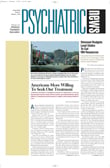The latter half of the 20th century saw the rapid transformation of psychiatry in Canada from ineffective to effective treatments, from provincial mental asylums to psychiatry units in general hospitals, and from minimal training standards for psychiatrists to a required five-year residency training program.
The Canadian Psychiatric Association (CPA) played a key role in this transformation, which is chronicled in a new book, Psychiatry in Canada: 50 Years, edited by former CPA president Quentin Rae-Grant, M.D. The CPA released the book at its annual meeting in Montreal last November.
Many Canadian psychiatrists belonged to APA in the first part of the 20th century. But by the 1940s, a growing number of them were discussing the need for a separate national organization to represent their interests, Rae-Grant told Psychiatric News.
Robert Jones, Ewen Cameron, George Stevenson, Aldwyn Stokes, C.B. Farrar, Griffith McKerracher, and Charles Stogdill (all M.D.s) played important roles in founding the CPA. It was officially founded in 1951 with 143 charter members. Many of them later became CPA presidents.
The CPA emerged at a critical time in Canada. World War II had ended, and the federal government was particularly interested in meeting the mental health needs of veterans. It began providing grants to improve psychiatric services in provincial hospitals and started to consider various health insurance reforms.
In 1960, the Canadian government appointed a commission to study health care services. The CPA’s Committee on Psychiatric Services was instrumental in developing recommendations on treating and preventing mental illness, which were presented to the federal commission and included in the commission’s final report.
The CPA played an important role in advocating for the inclusion of psychiatric services in the historic Canada Health Act initiated in 1967, said Rae-Grant. “The legislation mandated universal health coverage and made no distinction between medical and psychiatric services,” he said.
Because psychiatric services in general hospitals and private offices were fully covered for the first time, their use increased, according to Rae-Grant. More residents entered psychiatric training and began to practice in underserved areas.
However, the Canada Health Act did not cover psychiatric hospitals, which were funded by the provincial governments. They struggled to attract staff, but the deinstitutionalization movement in the 1960s and 1970s triggered their demise. Only a few of the provincial psychiatric hospitals remain open, with inpatient services largely being provided by psychiatric units in general hospitals, said Rae-Grant. Another important mandate for the CPA at that time was establishing training requirements. In the first part of the century, the only training requirement was that psychiatrists spend a year at a provincial psychiatric hospital, he said.
The Committee on Psychiatric Education, originally the Committee on Professional Standards, formed a critical alliance with the Royal College of Physicians and Surgeons of Canada, which certifies medical specialties, according to Rae-Grant. The first formal four-year training program was developed at McGill University in Montreal in the 1950s. By 1980, all 16 Canadian medical schools had departments of psychiatry with residency training programs.
Child and adolescent psychiatrists who were members of the CPA in the 1950s proposed subspecialty certification with additional training requirements. The CPA initially supported the separate certification recommendation but reconsidered because the specialty was so new. Instead, the CPA, with the approval of its Section on Child and Adolescent Psychiatry, proposed to the Royal College of Physicians and Surgeons that two years of optional training in child and adolescent psychiatry be allowed and counted toward the four-year training requirement. Training institutions would recognize the specialized training with the Diploma of Child and Adolescent Psychiatry.
In addition, the CPA recommended that all psychiatry residents be required to take six months of child and adolescent psychiatry training. The Royal College of Physicians and Surgeons approved all of the recommendations, said Rae-Grant.
Although the CPA Section on Child and Adolescent Psychiatry agreed to the two-year compromise in the 1950s, it has not dropped the issue of subspecialty certification.
Indeed, child and adolescent psychiatrists, forensic psychiatrists, and geriatric psychiatrists have been advocating since the 1990s for subspecialty certification by the Royal College, which the CPA supports, said Rae-Grant.
The CPA was instrumental in getting psychiatry included in the Royal College’s maintenance-of-certification program. Beginning last year, certified psychiatrists are required to take 400 hours of continuing professional development (CPD) over five years, according to Rae-Grant.
The CPA was approved by the Royal College in 1999 to accredit programs for psychiatric CPD sponsored by other medical organizations. The CPA also hosts accredited programs at its annual and international meetings that are supported by the pharmaceutical industry but meet the CPA’s strict standards, according to Dawn Haworth, director of corporate affairs for the CPA.
The CPA maintained close ties with APA, and Cameron, who served as CPA president from 1958 to 1959 previously served as president of APA for the 1952-1953 term.
It is a longstanding tradition that the presidents of the two associations attend each other’s annual meeting. APA has also long maintained district branches for Canadian psychiatrists.
Many Canadian psychiatrists also belong to the Canadian Medical Association, which has had a section on psychiatry since 1945. The CPA became an affiliate of the CMA in 1960 and has a delegate on the CMA General Council. The CPA also forged relationships with organizations representing people with mental illness, including the Canadian Mental Health Association, Schizophrenia Society of Canada, Mood Disorders Society of Canada, and National Network for Mental Health. Because stigma remains a barrier to psychiatric treatment, the CPA collaborated with these organizations to launch the first Mental Illness Awareness Week in Canada in 1991, said Rae-Grant.
These five groups formed the Canadian Alliance on Mental Illness and Mental Health in 1998 to advocate in a unified voice for improved treatment, education, and research. The alliance issued a national action plan on mental health in 2000 aimed at reducing stigma, developing a national research agenda including a national database on mental illness and mental health, and proposing national policies to improve psychiatric services, especially to underserved areas, according to the CPA (Psychiatric News, Oct. 15, 1999).
The Canadian government has historically underfunded mental health research, according to Rae-Grant. A national workgroup co-chaired by alliance chair Sylvia Geist, M.D., and Donald Addington, M.D., chair of the CPA Scientific and Research Committee, proposed a new Canadian Institute on Mental Illness and Mental Health Research in 2000.
The government launched the Canadian Institutes of Health Research last June, and an interim council recommended that one of the new research institutes be devoted to mental health, addictions, and the brain. The alliance was successful in getting several psychiatrists appointed to the research institute’s advisory board, according to the CPA.
Outgoing CPA President Michael Myers, M.D., told Psychiatric News that he plans to remain involved in efforts to identify and overcome stigma, which was the theme of his presidency and a goal of the mental health alliances’s national action plan.
“Suicide prevention was a major topic of the CPA’s 2001 annual meeting [Psychiatric News, January 18] and must be linked to efforts to reduce stigma and improve treatment of mental illnesses.
“I plan to pursue forging an alliance between the CPA and the Canadian Association of Suicide Prevention to discuss the need for a national suicide prevention action plan,” said Myers.
Myers, a corresponding member of the APA Committee on Physician Health, Illness, and Impairment, recently formed the CPA Section on Physician Health and plans to facilitate collaboration between the two committees.
The anniversary book Psychiatry in Canada: 50 Years is summarized on the CPA Web site at www.cpa-apc.org/anniversary.asp and can be ordered online for $16 (Canadian). ▪

